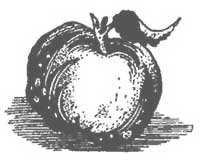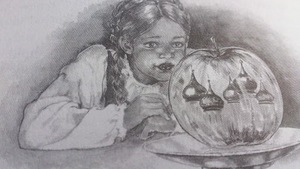 Anyway, the story of "The Silver Saucer and the Transparent Apple" is an interesting combination of a Cinderella tale with "The Singing Bone." It begins with the classic scene in which a father offers to buy gifts for his daughters; the eldest request dresses and jewels, and the youngest has a more unusual request. This youngest daughter is, of course, the most beautiful, and we are told over and over that she is good and she does all of the chores. She is called "Little Stupid" by her sisters (and even her father!)-sometimes we're so used to the name Cinderella we forget that name was also supposed to be an insult, more along the lines of "Dirty Ella."
Anyway, the story of "The Silver Saucer and the Transparent Apple" is an interesting combination of a Cinderella tale with "The Singing Bone." It begins with the classic scene in which a father offers to buy gifts for his daughters; the eldest request dresses and jewels, and the youngest has a more unusual request. This youngest daughter is, of course, the most beautiful, and we are told over and over that she is good and she does all of the chores. She is called "Little Stupid" by her sisters (and even her father!)-sometimes we're so used to the name Cinderella we forget that name was also supposed to be an insult, more along the lines of "Dirty Ella."Little Stupid requested a silver saucer and a transparent apple. No one else understands why, and they attribute the desire to her stupidity, but once she gets the items and spins the apple in the saucer, she is able to see anything she wants to, all over the world, in it. Her sisters become jealous, take Little Stupid into the woods, and kill her with an ax.
image-Patricia Ludlow-(Thanks Ozfan95!)
That spring, a reed is growing in the forest where the dead sister lay, and a shepherd comes by and uses it to make a flute. The flute begins singing all by itself, and tells him the story of how she was murdered. The flute is eventually taken to the girls' father, and he finds his daughter's body, and is able to bring her back to life with holy water from the Tsar. After that follows a more unsatisfactory ending (in my opinion) where she marries the Tsar and forgives her family, although the shepherd who originally found the reed is in love with her and I was rooting for him. In fact, the children who are being told the story felt the same way I did, and the narrator, Old Peter, explains that it was actually good because if he had married Little Stupid, he would have had to live with her whole nasty family. So...that's one way to look at it?
The Grimms' "Singing Bone" is a much shorter tale; a man is murdered by his brothers and his bone tells the story. Only in this one, the ending is more bittersweet, because while the bone allows the murdered man justice and his brothers are punished, he is not brought back to life. He is, however, given a proper burial. This tale somehow seems more satisfying to me; the ending of the other tale seems a bit forced. I normally don't mind too much the versions where Cinderella forgives her sisters (depending on how that part is worded), but at least they don't usually try to kill her! It hardly seems like a happy ending for her to live with her abusive family forever while the poor shepherd who actually rescued her doesn't get the girl. In fact, in none of the other related Singing Bone tales on Ashliman's site does the murdered person come back to life (although it does happen in other tales-see the comments for more discussion!), or are the murderers forgiven (although sometimes the remains don't sing, but bleed-it was widely believed in Medieval Europe that a murdered corpse would bleed in the presence of its murderer.)
Image



Anecdote time: When I was a kid, I owned many casettes of an audiodrama series for children. They consisted of short parts of public domain books, told as a serial and tales. The problem was that later into the series they ran out of kidfriendly tales. So one of the casettes had "The Singing Bone" on it. After a few times, I figured out which one it was and took it out of rotation for the bedtime entertainment. The problem was it still scared me, even if I listened to it during the day. But I never decided just to stop listening to it period. I don't know why. Iwas a stupid kid...
ReplyDeleteForgiving the family is more understandablefrom a pre-modern perspective, when idividualism was not an established value yet.
I actually disagree, for me the murdered coming back to life is more satisfying (even though I found the ending in "The Silver Saucer and the Transparent Apple" odd, too). Alishman's site is a great resource, but not the answer to everything. It's only a selection of tales and not really indicative of which ending is more widespread. I tried to find a source on that but Google-Fu didn't really help. I'd say that the murdered remain dead points to a later rationalization, similar to Blue beard stories, which also loose the elent of the vitims being brought back to life in newer retellings.
Trying to wrap my mind around viewing this tale (and others) from a less individualistic perspective...it's hard! Especially since, the whole family wouldn't necessarily move in with the first child to get married (right?).
DeleteI would love to find other versions of Singing Bone! Ashliman's site is the only resource I know of for a collection of some of the lesser known tales. Hopefully that didn't come across as being the only other versions out there, but I like to think they do provide a more well rounded understanding of the tales than just one version.
It's not so much living together, but that family (and to an extent other small communities like villages) used to be the only or only reliablekind of social security for a long time. Her father is wealthy now, but how much longer before he becomes too old to work? Her sisters are not married yet and may never be, since they, yknow, killed their sister and that's not very appealing. If a fairy tale introduces family members as villains, there are two options:
Deletea) The tale convinces us that they deserve to die and they get executed or killed by karma (which most tales do and *is* in fact the more satisfying ending)
b)The story teller thinks that for whatever reason lethal violence is not appropriate (for example, because of the moral standards during the time they live in), in which case the villain needs to be forgiven, because there is not much difference between a hero who drags their family before the judge and watches them get executed and a hero that leaves them to an uncertain future that may easily result in a cruel and untimely death. A good example of this is One Eye, Two Eyes and Three Eyes in which Two Eeyes goes to live with the king, forgetting about her cruel sisters, only to have them show up as almost starved beggarwomen not too much later, at which point she forgives them and makes them wealthy. A clever idea by the story teller who gets to teach a lesson about compassion, but also punish the villains for their deeds.
If I told the story today, I would probably do away wih the forgiving. But the option to just move far away and ignore your family if you don't get along with them, even if the reason is perfectly justified, is a relatively modern one
@more versions: One more version of the Singing Bone that I'm familiar with, is the Child's Ballad "The Twa Sisters". On the Wikipedia article there are also references to many other ballads and tales with similar stories. https://en.wikipedia.org/wiki/The_Twa_Sisters
Once again...all very helpful insights! Do you have your own blog? I would love to read your thoughts on fairy tales!
DeleteAnd thanks for the link to the Two Sisters tale page! Funny, for some reason the idea of playing a flute made out of bone doesn't seem as morbid, but a violin or harp made out of human hair is super creepy to me! (Plus I'm pretty sure human hair would make terrible strings...but that's probably part of the magic of how beautiful the murdered sister was, that she had super thick hair)
I know two versions where the boy is brought back to life in the end: the Catalan "The Romanial Flower" in which it turns out the titular flower magically preserved the boy from death, and the French "The Talking Bone." Both versions have the boy already be a king's son, and the brothers are competing to inherit their father's throne, rather than marry the princess.
ReplyDeleteThanks for sharing! Very interesting. I've updated the post
DeleteThe Hungarian version also has a happy ending, too, and you can watch it as the following cartoon: https://www.youtube.com/watch?v=8WsMwIa_U68
DeleteHey, sorry I didn't comment sooner. The Internet router shorted out during a thunderstorm, and I've been without Internet for awhile.
ReplyDeleteAnyway, the illustration that wasn't credited looked very familiar. I figured out immediately from the style of the illustration that the picture was from " A Treasury of Stories for Seven Year Olds," published by Kingfisher in 1992. That was the very book I first discovered the story from, and I still have the book. And we have the illustrator figured out now too! All illustrations from that book are by Patricia Ludlow.
Ooh thank you! I've updated the post
Delete